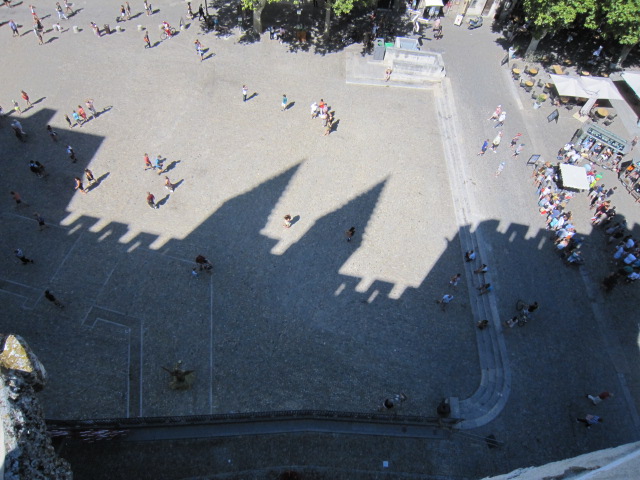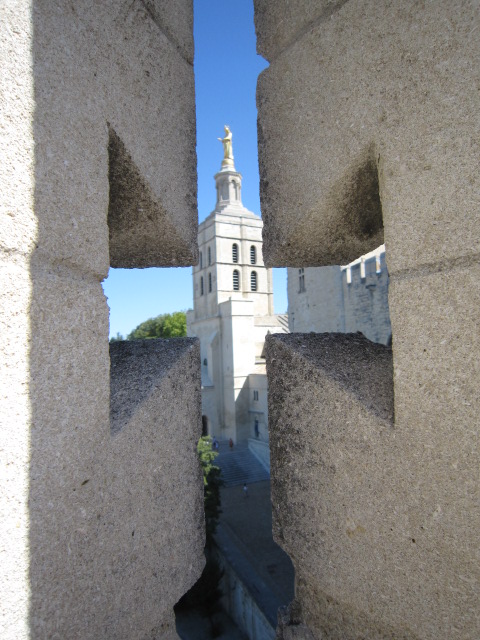This is the story of my ride in the Cyclosportive Vercors-Drome and how I ended up with a trophy.
I was up at 4:30 a.m. to drive to the start of the Cyclosportive Vercors-Drome. It was billed as a race or ride, depending on how you wanted to do it. You had a choice of three courses. One was 50 kms. the next 90 and the final 140 kms. There was a 6:30 a.m. sign in and it cost 7 Euros to participate.
It was too early to bring others to photograph me. It was also too important to keep riding for me to stop and take selfies (what my daughters have taught me is a name for photos taken of yourself) along the way. So please forgive the excessive prose of this post. But like the Moliere's Malade Imaginaire I am pleased to know that all that I'm writing is not just garbage, it is "prose".
To prepare for the Cyclosportive I rode at 7:30 a.m. the day before. This meant I had to get up early and get ready, eat and get on the road and experience the weather (cold in the early morning but warming up rather quickly).
I got there before 6:30 and found the start without the help of the GPS. I was disappointed to find out that they weren't timing the ride this year so it was just a ride, not a real race. They said they had lost a bunch of money the previous year because they didn't get enough participants and were expecting the same because they had canvassed some of the field and participation was going to be down due to injury, conflicting schedules etc.
I chose to do the 90 km. route. No sense in blowing my brains out on the 140 km. route with the difficulty of the climbs that I had experienced when I pre-rode them with Mimi the previous week.
You could leave any time after 7 a.m. (it was dark before that). I headed out just after 7 a.m. with a few other riders that were friendly and we chatted as we rode along the flats and false flats to the first of the 2 big climbs that featured in my route. One of the riders was Daniel. He was about my age and seemed to be of similar strength. We rode to the beginning of the Col Jerome Cavalli together and then Daniel began to pull away. This Col averages 4.8% over 9.7 kms. and climbs almost 580 metres over that distance. I sat in the saddle and ground away at the pedals and then alternated with shorter shifts standing on the pedals in the technique the French "la danseuse" (the dancer). In my case my "danseuse" was like the Ballet Trockadero of Monte Carlo version. (If you don't know the Ballet Trockadero you really must watch this video and check out others on You Tube of this troupe):
After Daniel had faded away into the distance I started feeling better and better and fewer cyclists were passing me. Then I started passing some cyclists who had passed me. Then I saw Daniel in the distance. Soon he was pulled back and then I passed him and pulled away on the second half of the climb to the top. I rode the downhill cautiously as there were a few dangerous turns that were banked the wrong way and I had had a close call on my trial ride the week before where I had to come to a complete halt and put my foot down on the gravel soft shoulder just before a steep embankment. Daniel managed to pull me back on the downhill to where I saw him a switchback below as I started the second climb, the Col de Bacchus.
On the Col de Bacchus I pulled away from him again and didn't see him again for the rest of the ride. I was passed by a few strong cyclists and as I climbed I was more and more exposed to the strong headwind. It was a tough day, up from the Col de Bacchus to the Col de Limouches. I set a personal best on the Col de Bacchus but the wind slowed me down on the Col de Limouches. (Incidentally they produce some of the best charcuterie (i.e. meats) at the Col de Limouches. A delicious pork saucissons that is like a salami. A wonderful caillette which is like a baseball sized pork meatball with spinach, onions etc. in it for flavouring. Hams, cooked and uncooked salted ones. So, much as I dislike tough climbs, I still enjoyed passing over the top of the Col de Limouches.)
After that there was an equally delicious downhill, but it too was ruined by the headwind. Then a flat stage to the finish. All good but for the wind. And for the fact I missed a turn and added 4 kms. to my ride. For the details of my ride click on the following link:
http://www.strava.com/activities/chabeuil-combovin-gigors-beaufort-gervenne-plan-de-baix-col-de-limouches-peyrus-combovins-drome-france-and-back-with-mimi-77698429?ref=1MT1yaWRlX3NoYXJlOzI9ZW1haWw7ND04Mjk2NzE%253D
When I pulled in the organizers and volunteers greeted me with a plate sporting a big slice of ham and a generous chunk of baguette, a typical French recovery snack as you step off the bike after a race or hard ride. There was also a chunk of chocolate on the plate and a Coca Cola was thrust into my hand.
Let me digress here about the perfect fuel that is Coca Cola for cyclists. This sugary liquid is jet fuel for glucose depleted muscles. Drink a Coke 15 minutes before the finish line of a race and, if the gas doesn't upset your stomach, you will be able to sprint without any effort. It is like the pedals start turning themselves. Pure magic. I never drink Coke but will make an exception when cycling. Those that do usually pour it into a plastic water bottle well in advance so that the gas has gone flat before drinking it, but I don't mind a good belch when the pedals are turning themselves. It is just proof of the explosive power you are putting out.
Back to my main story, however. I sat and ate the ham and baguette and chatted with the volunteers who had no one to talk to except each other. They interrogated me about everything. "Did you just complete the 50 km. course?" "No?" "The 90 km. course? Really?" Then they were running around and talking to each other. "Where are you from?" "If you don't mind me saying so you have a bit of an accent." "Canada? Really?" More running around and talking to each other. "What's Canada like?" "Do you have a democratic government?" "What is your retirement age in Canada?" "How many hours a week do you have to work in Canada?" "What line of latitude is Calgary on? Really?" I gathered I was exotic. I held court as another cyclist came in. Then another.
They then told me I was the first rider to come in to complete the 90 km. course. They then offered me a bowl of raviole, which are like little ravioli with fillings the French favour in the Drome province (Picodon fresh goat cheese, or Emmenthal for example). I declined saying I would have had the pasta for breakfast but didn't need it for lunch. They shook their heads in wonder. I was exotic.
Then from the table with 3 or 4 big trophies and 3 or 4 smaller ones an impressive older gent selected a smaller one and presented it to me. God knows what I got it for. On it was engraved UNFOLEP 26. I asked what that meant since I certainly didn't want to get a trophy that suggested I had finished 26th in anything. (This reminds me of the awards on the Wall of Gaylord in the Meet the Fockers movie.) But apparently UNFOLEP turned out to be the Union National Francaise d'Oeuvres Laique d'Education Physique which apparently organized the Cyclosportive. And 26 is the number of the department of the Drome which department's UNFOLEP was the organizer. Whew! Still the best I could explain what I got it for was that I was the best Canadian in the ride.
Although I asked, there was no Champagne to drink out of the trophy. Just Coke. But I brought the trophy back to Bourdeaux where Cristina, my hosts and some friends had assembled to visit with us. They treated it like a major award and I did all I could to not disabuse them of the idea.





































